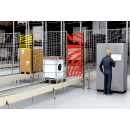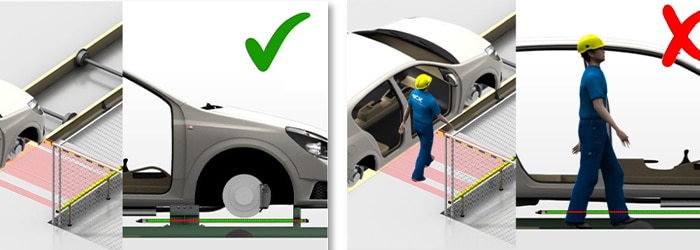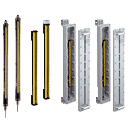Functional safety
For machines that commonly incorporate electro-sensitive protective devices (ESPEs), the relevant C-Type standards will often contain guidance regarding their application. For example, the EN 415 set of C-Type standards that cover the safety requirements for packaging machines contains lots of useful information.
EN 415-6 for pallet wrapping machines contains Annexes covering topics such as ESPEs in a vertical position, dynamic cell positioning of EPSE, and EPSE muting. However, this standard was published in 2013 and since then, newer technologies exist that can be used in these applications. Standards describe the state of the art and unfortunately, the development of standards can be slower than the progress of technology.
EN 415-6 refers to EN ISO 13849 & EN 62061 (now replaced by EN IEC 62061) with regards to the robustness of the control system that the ESPE is part of. These “safety-related” parts of the control systems (SRP/CS) need to be designed and constructed accordingly and must have a certain level of robustness appropriate for the level of risk reduction required.
EN ISO 13849 and EN IEC 62061 provide safety requirements and guidance on the principles for the design and integration of SRP/CS, including the design of software and specifies characteristics for carrying out safety functions (SFs). While either of these standards can be used, this article focuses on EN ISO 13849.
EN ISO 13849 provides examples of a number of typical safety functions, and it references other standards that are also relevant. For ESPEs and muting, it references EN ISO 13855 and IEC/TS 62046.
EN ISO 13855 covers the positioning of protective devices with respect to the approach speeds of the human body. The general formula for calculating the minimum distance is:
S = (K × T) + C
Where:
S = Minimum distance of the ESPE from the hazardous point
K = Approach speed of the human
T = Stopping/run-down time of the entire system
C = Intrusion distance (a supplementary value that changes based on both the resolution of the protective device and the possibility of reaching over)
SICK can provide help and guidance on this topic and has many documents that it can supply to customers. SICK also offers safety services such as stop time measurements to obtain a value for “T” in order to calculate the required minimum distance “S”.
EN IEC 62046 is a standard which was released after the publication of the current EN ISO 13849 standard. It is always advised to use the latest version of a standard. EN EC 62046 specifically covers the application of protective devices to detect the presence of persons and contains guidance on muting.
For a pallet wrapping machine, the following standards contain useful guidance on ESPEs:
- EN 415-6
- EN ISO 13849 / EN IEC 62061
- EN IEC 62046
- EN ISO 13855
However, this is not a comprehensive list and other standards will also be relevant, for example, EN 60204 for electrical safety, and EN ISO 14118 for the “prevention of unexpected start-up” to name a few.
C-Type standards normally contain information on muting and will refer to the other standards. If no C-Type standard exists, all relevant B-Type standards must be taken into consideration for risk reduction. If you are unsure with regards to which standard is applicable, then it is best to speak to an expert to get advice.
Standards cannot, however, contain guidance on technologies that have been developed since they were published. In this case, the standard can be used in conjunction with EN ISO 12100.
Standards relevant to muting
With regards to muting, C-Type standards will have guidance, but it would be a large task to go through all of the relevant C-Type standards. So, what do EN ISO 13849 and IEC 62046 say on this matter?
EN ISO 13849
EN ISO 13849 defines muting as a “temporary automatic suspension of a safety function or safety functions by the safety-related parts of the control systems (SRP/CS)”. There are a few important words here:
Temporary – How long is the safety function (SF) suspended?
- Automatic – How does the control system decide when to suspend the SF?
- Safety function – What SF is being suspended and how?
Let us consider a safety-related stop function initiated by a safety light curtain protecting the entrance to a pallet handling machine. When the material approaches the light curtain (full pallet), the control system must automatically detect the material and suspend the light curtain safety function (detection of people) to allow the material through (see Figure 2).


























